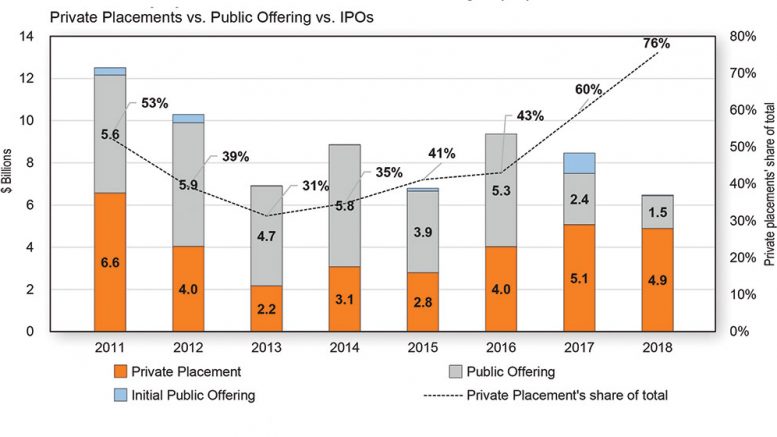The following is an edited excerpt from the report “State of mineral finance 2019: At the crossroads,” produced by the Prospectors & Developers Association of Canada (PDAC) and Oreninc. For the full report, visit www.pdac.ca.
From a broad perspective, global mineral exploration activity expanded in 2018, maintaining the positive trajectory established in 2017 after a multi-year contraction in activity from 2012 to 2016. Mineral exploration spending in Canada jumped 31% in 2018 versus one year prior, reflecting the second-largest regional increase after the U.S. at 34%. The rebound in North American activity well outpaced the rest of the world, which posted a year-over-year spending increase of 13%. Although exploration activity climbed in 2018, industry financing weakened notably, stalling the investment rebound established over the previous two years.
In last year’s PDAC report — “State of mineral finance 2018: Gaining momentum” — 2017’s rebound in mineral exploration activity was attributed to increased investment that related to wide-scale improvement in metal prices in 2016–2017. Expanding global growth expectations drove base metal price appreciation, and a weak U.S. dollar from 2016 to 2017 boosted positive precious metal price action over the two years. However, these dynamics shifted during 2018.
IMF global gross domestic product growth expectations for 2018 and 2019 have since been revised downward 5% and 10%. In a similar fashion, all base metals trended lower over 2018, with price drops ranging from 6% to 21%. The U.S. dollar index climbed nearly 7%, and its strong, inverse relationship with precious metals was maintained in 2018, as the monthly average gold price fell more than 5% from January to December — establishing the first negative annual price trend for gold since 2015. Surging prices of the two leading battery metals (cobalt and lithium) also lost steam in 2018, possibly due to supply and demand fundamentals supplanting recent market speculation.

Exchange financings of juniors by commodity type in 2018. Source: Oreninc.
Metal price weakness likely drove declining 2018 investment. Mineral industry equity financing in 2018 dropped nearly 35% from a year earlier to establish a new decade low for both total value raised and number of transactions completed. While funding specifically for exploration remained above 2013 and 2015 lows, in 2018 it declined more than 50% from a year earlier to less than one-quarter of peak investment levels established in 2012. Also concerning is the 40% year-over-year drop in bought-deal financing for junior explorers to $0.6 billion in 2018, which is the lowest figure recorded in a decade, and hints at a lack of sector confidence by large brokerages.
Growth in passive investments and alternate high-risk sectors (i.e., cannabis, blockchain) has also contributed to a recent drop in mineral industry investment. Strategic reinvestment by major mining companies has offset some of these impacts, with sector reinvestment increasing more than fivefold from 2013 to 2017. However, margin expansion through higher metal prices or cost reductions may be necessary to sustain reinvestment by major miners into junior explorers.

Junior fundraising (private placement) distribution by market capitalization in 2018. Source: Oreninc.
Canada’s mineral industry was better shielded but not immune from declining investment, as both equity and exploration-specific financing fell 25% year-over-year on domestic exchanges. With a more moderate slowdown, Canada represented a larger proportion of 2018 global exploration. However, domestic activity remains well below recent peaks. While “grassroots” spending edged up in nominal terms, the proportion of grassroots exploration spending continues to decline both at home and abroad, reaching a decade low in 2018.
PDAC advocacy posted a major win in 2018, with renewal of the Mineral Exploration Tax Credit for five years. PDAC is engaged with the Canada Revenue Agency to improve clarity of Canadian Exploration Expense eligibilities for industry participants, and with the Canadian Securities Administrators and the Ontario Securities Commission to streamline processes and lower capital costs through a burden-reduction project. While PDAC’s advocacy efforts are aimed towards increasing access to capital and mineral industry investment, the trajectory of commodity prices in 2019 will likely have the largest influence on mineral industry financing and exploration activity levels over the coming 12–18 months.






Be the first to comment on "PDAC-Oreninc report: Mineral investment facing headwinds"